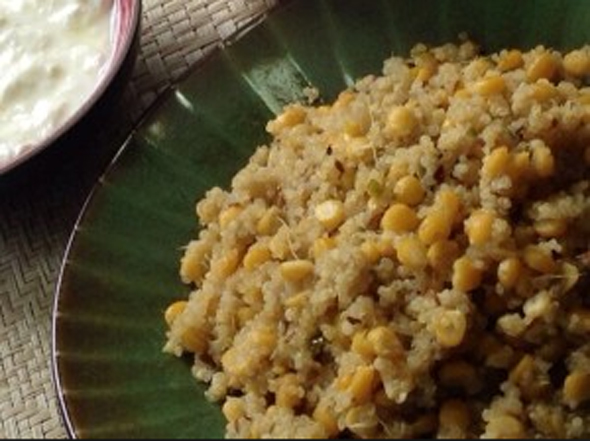Mama’s Punjabi Recipes: Channe di Dal di Khichdi (Rice & Channa Lentils)
There are many variations in the ingredients that you can use to make khichdi, just as there are many types of paranthas. It all depends on your taste and also the foods you ate while growing up. Though khichdi is basically made from chawal (rice) and dal (lentils), its popularity among many families comes from the simplicity and ease with which it can be prepared. It is a favorite of many rice-eaters, many of whom like it made with more water so that it is thin and runny.
Another reason is that khichdi is a comfort food to which you can easily add extra flavor with dahi (yogurt) and aachars (pickles). The whole eating experience is very informal and familiar. What’s more, at the end, there aren’t that many plates to wash!!
Khichdi is usually made with moong dal because it is easily digestible and has high carbohydrate content. But it can just as easily be made with other dals too like urad (black dal) or channa (yellow dal), depending on your taste and the texture you want. Punjabis who are accustomed to eating mah-channe di dal sometimes prefer khichdi with channa dal.
And for many young people, especially those living outside India, who aren’t familiar with preparing Indian dishes and think it is too time consuming to make, khichdi is a quick and easy primer for learning the first steps of Indian cuisine.
Ingredients:
2 cup basmati chawal (Basmati rice)
1 cup channa dal (skinless split channa lentils)
6 cups pani (water)
2 tbspn olive oil
1 tspn jeera (cumin)
4 laung (cloves)
2 sticks dal chinni (cinnamon) – broken into smaller pieces
1 tspn garam masala
Spices: namak (salt) – to your taste
Directions:
1. Place the channa dal in a bowl and wash it thoroughly in cold water then let it soak for 30 minutes. Do the same with the rice and put it aside.
2. Bring 2 cups of water to a boil over high heat. When it starts to boil, drain the water from the channa dal and pour it into the pot.
3. Cover and let the dal boil for only 10 minutes, then take it off the heat and run the dal through a strainer, but don’t throw away the water, catch it in a bowl for use later.
4. Place a large pot over medium heat, pour in the oil then add the jeera and stir till the smell comes out.
5. Drain the water from the rice and add to the pot and mix thoroughly. Add 4 cups of water and bring to a boil.
6. Add the channa dal, then throw in the laung, dal chinni and salt to taste and cover on low heat.
7. After 5 minutes, add the saved water from draining the dal, mix thoroughly and let it cook under low heat for 10 minutes.
8. When the rice and dal appear to be nicely mixed together then turn off the heat, cover and let it sit for 10 minutes. Do not stir often while cooking.
9. Sprinkle the top of the khichdi with garam masala and serve while still hot. This dish cooks like a pilau and tastes good with aamb da achaar (mango pickle) and some plain yogurt too.
MAMA’S TIP OF THE WEEK
CLEANING HARD TO REMOVE STAINS FROM POTS AND PANS
Cooking Indian dishes can often be hard on pots, pans and other dishes, leaving stains and hard to remove residue on the sides and bottom of these utensils. Most people usually scrape the surfaces with a rough edge or a hard sponge, but these can leave scrapes and scratches on the pots.
There are two ways to try to clean stubborn residues and stains. You can try to immerse the pots in hot water with a cup of white vinegar in it. And to clean the insides, fill with water, then let it boil over medium heat for a few minutes with a cup of white vinegar or lemon, then remove and let it sit for a while before dumping the water and then try scrubbing with Ajax and sponge off.
If all else fails, try to scrub the stain and residues with a wet Brillo pad and then let it stand for a while before continuing to sponge off with dish washing liquid.
Shakuntla Malhotra is a skilled cook of Punjabi dishes made in the old-fashioned style that she learnt as a young woman in her ancestral home in Lyallpur, India before it became part of Pakistan after the Partition in 1947. People have often admired her cooking for its simplicity and taste that comes with each mouthful. Even in her mid-eighties, she continues to cook daily and agreed to share some of her delectable Punjabi recipes.


